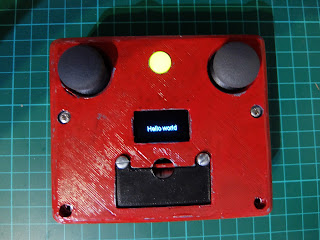More digital calliper data
Unlike some of the links in my previous article, my callipers output only one value, it is not 2's complement - but has a sign bit, and it changes if you switch between mm and inches on the scales - either hundredths of a mm or inch respectively.
I've managed to solder some wires onto another defective set without breaking them, which has made figuring all this out easier. Perhaps just ESD damage to the other one? Since this isn't the set I'm actually going to use, and there's obviously some variation, I'm going to stop messing around with these, and start experimenting with the carbon fibre ones I'm actually going to use.
The reason for using carbon fibre instead of stainless steel is just it should be easier to cut them up. I should be able to cut the jaws off with a diamond burr or similar, and people also seem to manage with a hacksaw.
It turns out my carbon fibre callipers are slightly different. I tried out the logic analyser with my bitscope. Here's what zero (0.0) looks like:
And another one, after moving the callipers a bit (-42.7):
There's nothing very interesting here: there are 24 rising edges. It's just that for some reason there's a pause every 4 bits. The 0 bit is a 'start' bit - it's always 1. Bit 20 is a sign bit. In between is the absolute value in hundredths of an mm, assuming the callipers are in mm mode.
I can't get any sort of mode change, or zeroing by manipulating the data or clock pins. What I've ended up doing is just adding a p-channel mosfet that turns the whole thing off - which zeros the callipers and ensures they are on afterwards. The callipers seem to be able to get power from the pull up resistors on the data and clock lines, so they need to be turned off too:
I'm managed to get the transistor converter to work this time.
I've managed to solder some wires onto another defective set without breaking them, which has made figuring all this out easier. Perhaps just ESD damage to the other one? Since this isn't the set I'm actually going to use, and there's obviously some variation, I'm going to stop messing around with these, and start experimenting with the carbon fibre ones I'm actually going to use.
The reason for using carbon fibre instead of stainless steel is just it should be easier to cut them up. I should be able to cut the jaws off with a diamond burr or similar, and people also seem to manage with a hacksaw.
It turns out my carbon fibre callipers are slightly different. I tried out the logic analyser with my bitscope. Here's what zero (0.0) looks like:
And another one, after moving the callipers a bit (-42.7):
There's nothing very interesting here: there are 24 rising edges. It's just that for some reason there's a pause every 4 bits. The 0 bit is a 'start' bit - it's always 1. Bit 20 is a sign bit. In between is the absolute value in hundredths of an mm, assuming the callipers are in mm mode.
I can't get any sort of mode change, or zeroing by manipulating the data or clock pins. What I've ended up doing is just adding a p-channel mosfet that turns the whole thing off - which zeros the callipers and ensures they are on afterwards. The callipers seem to be able to get power from the pull up resistors on the data and clock lines, so they need to be turned off too:
I'm managed to get the transistor converter to work this time.




